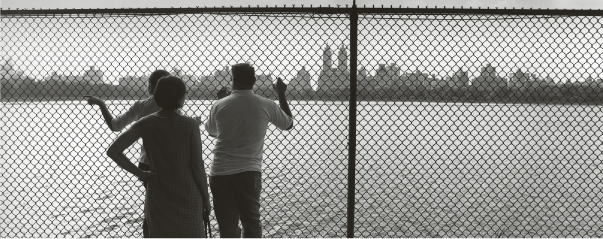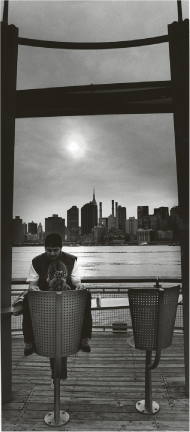22 Balance in a Photo
You have seen that every image has an underlying abstract structure that determines its pictorial composition. There are infinite possibilities for creating such a structure, but among all these possibilities one essential thing should not be forgotten: The structure must be balanced; it should not appear to tip over to one side.
Let’s look at the photo in figure 22–1: A window cleaner swings high over Frankfurt in his suspended balcony. The window cleaner’s box dominates the left side of the picture and there is no counterweight on the right but the photo does not become unbalanced. The reason is that we read images from left to right. Your eye enters the photo on the right side of the suspended balcony, looks briefly at the man, but then moves quickly to Frankfurt’s Western Harbor. The main point of interest is the tower located in the center, which is the perpendicular axis of symmetry. Above the tower, you can see a cloud moving in that leads your eye from left to right and out of the picture. This reading movement is precisely what creates the movement to the right that serves to counteract the strong dominance of the balcony.
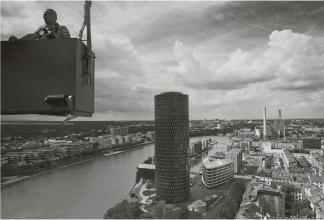
If you turn the photo around, however, the balance is gone (figure 22–2). Now your gaze is quickly led by the floating cloud to the window cleaner and his base. The unbalanced photo definitely tips over to the right because there is too much weight on the right. Its left side desperately needs a much stronger counterweight than what the passing cloud can provide to restore balance. It’s amazing how deeply the left-to-right reading direction is ingrained in Western civilization, even when you perceive and analyze images.

Formats and Diagonals
The creation of balance in an image is one of the most basic criteria of pictorial composition and it can be expertly used in many applications. Various formats and their principles are an important basis for this:
• A horizontal format is likely to be static and resistant.
• A panoramic horizontal is the most static and is therefore a stable and calm format.
• A vertical format is generally dynamic and less stable in the sense that it can appear to tip over and lose its balance more easily.
• A panoramic vertical format intensifies vertical properties.
A panoramic vertical format is wonderfully dynamic here (figure 22–3), where oblique lines create a balance. The photo shows one of the large buttresses and both steel suspension cables of the Brooklyn Bridge in New York. They have been photographed in such a way that the perfectly balanced oblique lines infuse it with life and don’t allow the image to tip over. The steel cables of this gigantic bridge stress the so-called “positive diagonal” (the diagonal moving upward from bottom left to upper right) because our gaze follows it from left to right. In this photo, the suspension lines lead us to the stone buttress of the bridge.
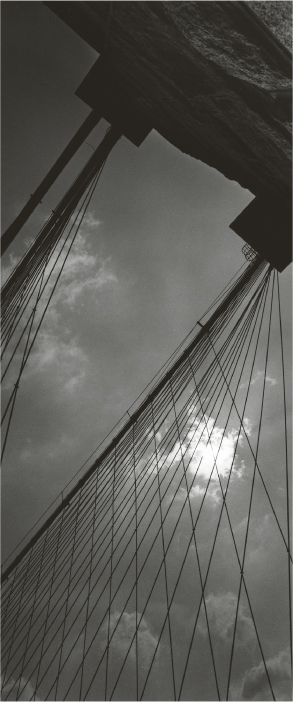
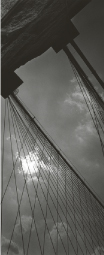
If we flip this photo over (figure 22–4), the effect is radically different. The eye is now more likely to be led out of the image because the so-called “negative diagonals” that move downward are emphasized here.
The next photo is somewhat more static (figure 22–5). At least the city of New York appears to be resting on a horizontal axis, while two oblique lines move toward the same vanishing point in the upper and lower sections of the image. The oblique lines of the Brooklyn Bridge suspension cables and the shadow of the railing in the lower part make the photo dynamic, yet this dynamic quality is embedded in a certain static order because the two oblique lines are mirror images of each other and can be reflected on the horizontal axis of symmetry. Therefore, this photo is very carefully balanced: Its compositional strength comes not only from the graphic detail of the wire cables, the railing, and its shadow, but also from the mood created by the back-light. To intensify the mood in this photo (taken with an analog camera), it was important to burn in the sky in the darkroom.

The next picture also has a certain atmospheric quality (figure 22–6). Here we have a statically-composed photo taken in an extremely dynamic format. The photo is perfectly balanced; the frame intensifies the static impression and it is almost a photo within a photo. The urban silhouette lies more or less on the horizontal axis; the railing below lies almost exactly on the lower horizontal harmonic dividing line. In the upper part there is yet another photo within a photo in classical rectangular format subdivided by an arched brace. What makes the photo especially attractive, however, is the courting couple so intensely interested in each other that they do not notice being photographed. The same principle applies in this picture: Backlight creates a mood. The sun shines through a hazy sky, but it is precisely this slight haze that gives the image its special mood.
This photo was taken with an analog camera and had to undergo a long darkroom manipulation to make the sun stand out in the sky; such a lighting situation is the biggest challenge for digital cameras. You can manipulate the lighting by using a gradient filter, and underexpose in a way that will resemble the result obtained with a Mamiya 645 middle-format camera. Such a lighting situation will really put the actual quality of the digital sensor to the test.
It is difficult to make the panoramic horizontal photo in figure 22–7 lose its balance. This picture was also taken in New York and shows the towering skyline of Manhattan on the opposite side of a lake in Central Park. Yet the skyline can be seen only through a fence. Father, mother, and child “hang on” to this fence—family idyll and urban idyll are separated from one another by this fence. Is this photo trying to say something once again? Why has this small lake in Central Park been fenced in and was it necessary? Why must nature be protected from humans in the twenty-first century? In any case, the fence does not seem to bother the family as they enjoy the urban idyll by looking through the small openings of the fence.
